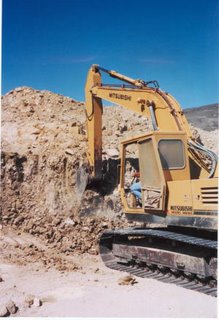
The world’s most famous black fire opal was discovered in Nevada’s remote Virgin Valley in 1917.
Colonel W.A. Robeling, a civil engineer who helped design and construct New York’s famed Brooklyn Bridge, uncovered the precious stone in 1917.
The magnificent 2,610-carat opal, which weighs about one and a half pounds, was later donated by Robeling to the Smithsonian Institute. It’s on display in the Smithsonian’s Gem Hall, along with several other smaller but equally beautiful black opals from Nevada.
It was with such knowledge in mind that my daughter and I traveled to the Virgin Valley area, located about 135 miles northwest of Winnemucca, to seek our fortunes.
Virgin Valley, in fact, is renowned for its opals, which include not only the rare black fire opal but also a wide variety of other opal-type stones.
Geologists trace the origins of the region’s opals back to one of Nevada’s violent volcanic periods, which occurred about 20 million years ago. During that time of great upheaval, a basin was formed in the area.
Over the years, the basin filled with sediments and volcanic ash as well as deposits of silica. Eventually, forests that had cropped up in the basin were buried beneath the layers of sediment.
The valley’s opals essentially are created by the combination of warm underground water, silica deposits and buried wood. Over time, this geological cocktail develops into opalized wood that can also develop into precious opal stones.
In more recent times, geologic forces caused the valley to uplift, which exposed the valley’s clay beds of prehistoric volcanic ash. It is in these beds that you can find precious opals.
Since the early 20th century, miners have been working the Virgin Valley ground for opals. One of the oldest mines in the region, which is still in operation, is the Rainbow Ridge Opal Mine.
Rainbow Ridge, in fact, is where I was able to do a bit of opal hunting. The opal hunting process, at least at Rainbow Ridge, is that you basically sit down next to a pile of rocks and begin sifting through them to find anything that looks interesting.
Opal hunters have two options for their piles—they can either pick through tailings, which are mounds of rocks that other people have already gone through, or, for a bit more money, have a backhoe dump a pile of fresh dirt on the ground, which they can pick through.
The picking is where the fun begins. At first, you haven’t the faintest clue what you’re looking for. However, the Rainbow Ridge folks are extremely helpful in providing pointers.
Tools are pretty simple and are usually available from the mine. They can include small picks, hammers, shovels, and hand trowels. It’s also essential to have a small bucket of water in which to store your potential opal finds.
The reason for the bucket of water is that the ground in Virgin Valley is extremely moist, meaning the opals are accustomed to a wet environment. Opals removed from the moist dirt can begin to crack as they dry out (ask the mine how best to preserve any stones you might find).
Once you literally begin to dig in you find that the tailings or virgin mounds are filled with interesting stuff. It’s not uncommon to find opalized wood (it looks like white bone) or hunks of petrified wood.
Occasionally, as you sift through the dirt, you’ll also spot glassy-looking rocks. Veteran opal hunters encourage you to save anything glassy-looking in your water bucket because it may yield an opal once it’s been cleaned up.
And if you’re real lucky you might even find one of the elusive black fire opals. These magnificent gems are dark-colored stones that, when exposed to direct sunlight, sparkle with the hues of a rainbow.
So, did we find anything valuable during our journey to the Virgin Valley? As a matter of fact, my daughter uncovered a pair of beautiful, rainbow-hued opals, each measuring about a half-inch in length.
We were able to have them cleaned up and placed inside of a small, glass globe filled with water in order to keep them preserved. My daughter likes to hold the globe to a light to see the rainbow colors reflect off the stones.
I don’t know if they are actually worth much but they’re priceless to her.
The Rainbow Ridge Opal Mine is located about 35 miles west of the Denio Junction via State Route 140. The road, which is marked, is paved until the last 7.5 miles, which are graded dirt and gravel.
The mine is open daily from 8 a.m. to 4 p.m. from May to the end of September. For more information, go to www.nevadaopal.com.
In addition to Rainbow Ridge, Virgin Valley is home to several other commercial mine-your-own operators also open from May to September including: the Royal Peacock Mine (www.royalpeacock.com) and the Opal Queen (www.opalqueen.com).




Very interesting to read about the Nevada opals, I was not aware of the scale of things overe there.
ReplyDeleteWhat opal story would be complete without mention of the richest opal region in the world: Australia.
If you are interested in opals, opal mining or general rockhound chatter, please introduce yourself at Opal Auctions Official Forums
This says it all, "I don’t know if they are actually worth much but they’re priceless to her."
ReplyDeleteThis says it all, "I don’t know if they are actually worth much but they’re priceless to her."
ReplyDeleteCertainly more precious then coming from a synthesized plastic in a lab
ReplyDelete